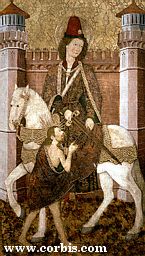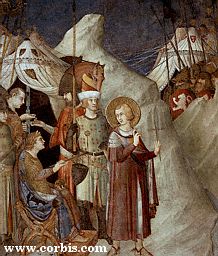Readings:
Hosea 2:18-23
Psalm 11
Galatians 6:1-2
Matthew 25:31–40Preface of a Saint (2)
[Common of a Monastic or Professed Religious]
[Common of a Pastor]
[Of the Incarnation]
[For the Ministry II]
PRAYERS (traditional language)
Lord God of hosts, who didst clothe thy
servant Martin the soldier with the spirit of sacrifice and set
him as a bishop in thy Church to be a defender of the catholic faith: Give
us grace to follow in his holy steps, that, at the last, we may be found
clothed with righteousness in the dwellings of peace; through Jesus Christ
our Lord, who liveth and reigneth with thee and the Holy Spirit, one God,
now and for ever. Amen.
PRAYERS (contemporary language)
Lord God of hosts, who clothed your servant
Martin the soldier with the spirit of sacrifice and set him as a bishop
in your Church to be a defender of the catholic faith: Give us grace to
follow in his holy steps, that, at the last, we may be found clothed with
righteousness in the dwellings of peace; through Jesus Christ our Lord,
who lives and reigns with you and the Holy Spirit, one God, now and for
ever.
Amen.
Lessons revised at General Convention 2024
Return to Lectionary Home Page
Webmaster: Charles Wohlers
Last updated: 14 Sept. 2024
MARTIN OF TOURS
BISHOP AND THEOLOGIAN (11 NOV 397)
 Martin
was born around 330 of pagan parents. His father was a soldier, who enlisted
Martin in the army at the age of fifteen. One winter day he saw an ill-clad
beggar at the gate of the city of Amiens. Martin had no money to give,
but he cut his cloak in half and gave half to the beggar. (Paintings of
the scene, such as that by El Greco, show Martin, even without the cloak,
more warmly clad than the beggar, which rather misses the point.) In a
dream that night, Martin saw Christ wearing the half-cloak. He had for
some time considered becoming a Christian, and this ended his wavering.
He was promptly baptized. At the end of his next military campaign, he
asked to be released from the army, saying: "Hitherto I have faithfully
served Caesar. Let me now serve Christ." He was accused of cowardice,
and offered to stand unarmed between the contending armies. He was imprisoned,
but released when peace was signed.
Martin
was born around 330 of pagan parents. His father was a soldier, who enlisted
Martin in the army at the age of fifteen. One winter day he saw an ill-clad
beggar at the gate of the city of Amiens. Martin had no money to give,
but he cut his cloak in half and gave half to the beggar. (Paintings of
the scene, such as that by El Greco, show Martin, even without the cloak,
more warmly clad than the beggar, which rather misses the point.) In a
dream that night, Martin saw Christ wearing the half-cloak. He had for
some time considered becoming a Christian, and this ended his wavering.
He was promptly baptized. At the end of his next military campaign, he
asked to be released from the army, saying: "Hitherto I have faithfully
served Caesar. Let me now serve Christ." He was accused of cowardice,
and offered to stand unarmed between the contending armies. He was imprisoned,
but released when peace was signed.
He became a disciple of Hilary of Poitiers, a chief opponent in the West of the Arians, who denied the full deity of Christ, and who had the favor of the emperor Constantius. Returning to his parents' home in Illyricum (Yugoslavia, approximately), he opposed the Arians with such effectiveness that he was publicly scourged and exiled. He was subsequently driven from Milan, and eventually returned to Gaul. There he founded the first monastary in Gaul, which lasted until the French Revolution.
In 371 he was elected bishop of Tours. His was a mainly pagan diocese, but his instruction and personal manner of life prevailed. In one instance, the pagan priests agreed to fell their idol, a large fir tree, if Martin would stand directly in the path of its fall. He did so, and it missed him very narrowly. When an officer of the Imperial Guard arrived with a batch of prisoners who were to be tortured and executed the next day, Martin intervened and secured their release.
 In
the year 384, the heretic (Gnostic) Priscillian and six companions had
been condemned to death by the emperor Maximus. The bishops who had found
them guilty in the ecclesiastical court pressed for their execution. Martin
contended that the secular power had no authority to punish heresy, and
that the excommunication by the bishops was an adequate sentence. In this
he was upheld by Ambrose, Bishop of Milan. He refused to leave Treves
until the emperor promised to reprieve them. No sooner was his back turned
than the bishops persuaded the emperor to break his promise; Priscillian
and his followers were executed. This was the first time that heresy was
punished by death.
In
the year 384, the heretic (Gnostic) Priscillian and six companions had
been condemned to death by the emperor Maximus. The bishops who had found
them guilty in the ecclesiastical court pressed for their execution. Martin
contended that the secular power had no authority to punish heresy, and
that the excommunication by the bishops was an adequate sentence. In this
he was upheld by Ambrose, Bishop of Milan. He refused to leave Treves
until the emperor promised to reprieve them. No sooner was his back turned
than the bishops persuaded the emperor to break his promise; Priscillian
and his followers were executed. This was the first time that heresy was
punished by death.
Martin was furious, and excommunicated the bishops responsible. But afterwards, he took them back into communion in exchange for a pardon from Maximus for certain men condemned to death, and for the emperor's promise to end the persecution of the remaining Priscillianists. He never felt easy in his mind about this concession, and thereafter avoided assmblies of bishops where he might encounter some of those concerned in this affair. He died on or about 11 November 397 (my sources differ) and his shrine at Tours became a sanctuary for those seeking justice.
The Feast of Martin, a soldier who fought bravely and faithfully in the service of an earthly sovereign, and then elisted in the service of Christ, is also the day of the Armistice which marked the end of the First World War. On it we remember those who have risked or lost their lives in what they perceived as the pursuit of justice and peace.